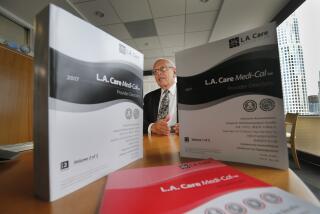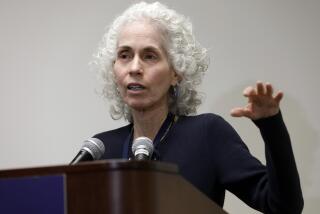A Public-Private Partnership in Health Care
In response to escalating health care costs, counties around the nation--including Los Angeles--are developing new lower-cost systems to better treat low-income families. Mandy Johnson, executive director of the Community Clinic Assn. of Los Angeles County, has worked to restructure the 24 free health clinics her organization represents. The Los Angeles County Board of Supervisors is expected to discuss the public-private health care contract at their meeting Tuesday. Johnson spoke with LUCILLE RENWICK about the changes.
Inflation in health care has outpaced general inflation for many years. The other thing is, we’ve been in a recession and not only have the welfare rolls gone up, but the number of people needing subsidized health care has gone up. Plus, the number of employers who offer health insurance to their workers is declining.
In the health clinics, the majority of the people they see are working families with two and three jobs. For people who are day laborers, housekeepers and gardeners, there is no health insurance. So the idea of the new system was to do a number of things: to solve L.A. County’s financial crisis in its health budget and to increase access to primary health care.
The theory is that if you can get people into a primary care system, you should provide appropriate care and intervention and thus avoid the long-term costs that occur when people need immediate care.
A recommendation was made by the L.A. County health crisis task force to develop a system of primary care based on public-private partnerships. With that you could take care of people in a low-cost, appropriate setting--the doctor’s office or the clinic--for routine health care.
The county has set up referral systems in regions so that when a patient is seen in a clinic, the clinic can call a referral nurse, fax over the necessary paperwork and the patient is then tracked to make sure they go. All the geographic areas in the county are setting up the referral networks a little differently.
The new program is built around the federal poverty guidelines and eligibility for the program is the same as eligibility for the Medi-Cal program. Families at or below 133% of the federal poverty line and who are not eligible or receiving Medi-Cal or any kind of insurance are eligible for free services. A single person must have an income at or below $860 a month to be eligible. The income for a family of four has to be at or below $1,733 a month.
The benefits of the new system are increasing access for these low-income families. Under the old system, the county was not providing comprehensive care in very many locations, [only] at its six comprehensive centers. Its other health centers were only offering basic public health services: TB screening, pregnancy testing, prenatal care.
So what you had--and still have--was low-income families primarily accessing health care through the emergency rooms. I haven’t seen any estimates of the cost, but compared to the $550 it costs just to walk in the door of an emergency room, it will be far less than that.
With the new system, they’ve developed contracts with the private sector and have gone from the county’s network of 45 clinics to a network of 103 sites around the county.
There’s been a learning curve on the county’s side in how to do this. There has not been a lot of trust by the private sector of the county because there’s a long history in how the county has not worked with the private sector. So there are a lot of historical barriers that have to be overcome to build trust and faith and a system that’s going to work.
For more information: The Community Clinic Assn. can be reached at (310) 649-7350.
More to Read
Sign up for Essential California
The most important California stories and recommendations in your inbox every morning.
You may occasionally receive promotional content from the Los Angeles Times.









